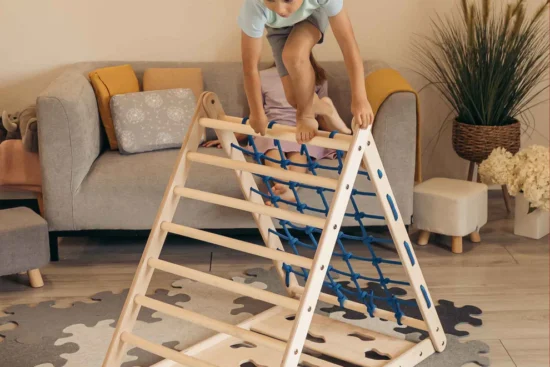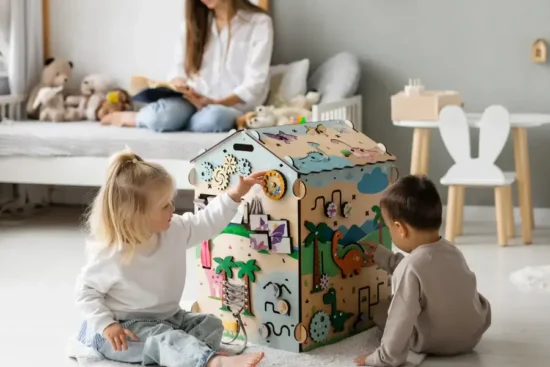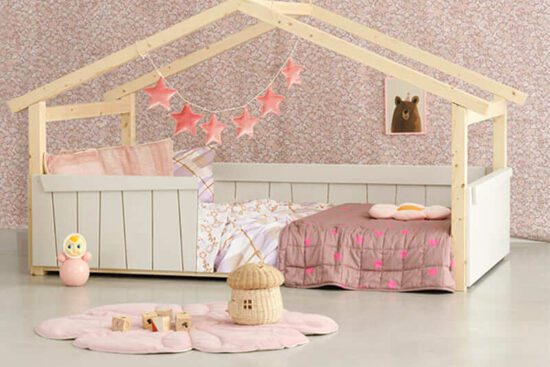Kinder lieben es zu klettern. Sie erklimmen Sofas, Stühle und alles, was ihnen in den Weg kommt. Doch Klettern ist nicht nur ein Spiel, sondern auch ein wichtiger Bestandteil der kindlichen Entwicklung. Besonders das Klettern in Innenräumen auf Kletterdreiecken, Kletterwänden, Kletterbögen und Rutschen fördert zahlreiche Fähigkeiten. Dabei entdecken Kinder spielerisch ihre eigenen Grenzen und lernen, mit Herausforderungen umzugehen. Doch warum ist das so wichtig? Welche konkreten Vorteile bringt das Klettern für die Entwicklung von Kindern?
Motorische Entwicklung
Beim Klettern werden viele Muskelgruppen beansprucht. Kinder verbessern ihre Kraft, Koordination und Balance. Besonders das Greifen, Ziehen und Drücken stärkt die Muskulatur. Dies hilft nicht nur beim Klettern selbst, sondern auch bei anderen Alltagsbewegungen wie Laufen, Springen oder Schreiben. Ein gut trainierter Körper unterstützt die Haltung und kann später Haltungsschäden vorbeugen. Zudem wird das Gleichgewicht intensiv geschult, was für viele weitere sportliche Aktivitäten von Vorteil ist.
Förderung der Fein- und Grobmotorik
Klettern trainiert sowohl die grobmotorischen als auch die feinmotorischen Fähigkeiten. Beim Festhalten von Sprossen oder Griffen wird die Handkraft gestärkt. Die Kletterbewegungen erfordern zudem eine gezielte Abstimmung von Armen und Beinen. Dies fördert die Koordination und schult das Körpergefühl. Besonders das Überkreuzen der Körpermitte beim Klettern hat einen positiven Einfluss auf die Gehirnentwicklung und unterstützt die spätere Schreib- und Leseentwicklung. Durch die regelmäßige Nutzung von Klettergeräten können Kinder eine bessere Körperkontrolle und ein besseres Gefühl für Bewegung entwickeln.
Kognitive Entwicklung
Beim Klettern müssen Kinder Hindernisse bewältigen und Lösungen finden. Sie lernen, ihre Bewegungen zu planen und einzuschätzen. Dies verbessert das logische Denken und die Problemlösungsfähigkeit. Zudem wird die Raumwahrnehmung geschult, was später beim Schreiben und Lesen hilfreich ist. Kinder entwickeln ein Gefühl für Distanzen, Höhen und Geschwindigkeiten, was sich positiv auf ihre allgemeine Orientierung auswirkt. Darüber hinaus lernen sie, Risiken richtig einzuschätzen und bewusst Entscheidungen zu treffen, was ihre Selbstständigkeit und ihr Verantwortungsbewusstsein stärkt.
Stärkung des Selbstvertrauens
Wenn Kinder eine Höhe erklimmen oder eine neue Bewegung meistern, fühlt sich das wie ein großer Erfolg an. Diese Erfolgserlebnisse stärken das Selbstbewusstsein. Kinder lernen, Herausforderungen anzunehmen und ihre eigenen Fähigkeiten besser einzuschätzen. Durch das schrittweise Überwinden neuer Hürden wächst ihr Vertrauen in die eigenen körperlichen und geistigen Fähigkeiten. Zudem hilft das selbstständige Klettern, Ängste abzubauen und Mut zu entwickeln. So werden Kinder ermutigt, auch in anderen Lebensbereichen selbstbewusst neue Dinge auszuprobieren.
Soziale Kompetenz
Klettern ist oft eine gemeinsame Aktivität. Kinder motivieren sich gegenseitig, helfen einander und lernen, auf andere zu achten. Sie erfahren, wie wichtig Kommunikation und Teamarbeit sind. Besonders in einer Spielgruppe oder Familie kann das Klettern so soziale Fähigkeiten stärken. Zudem lernen sie, Rücksicht zu nehmen und Verantwortung für ihre Mitspieler zu übernehmen. Das gemeinsame Klettern fördert das gegenseitige Vertrauen und stärkt den Teamgeist. In einer sicheren Umgebung können Kinder so spielerisch erste soziale Regeln verstehen und umsetzen.
Pikler Pädagogik und Indoor-Klettergeräte
Die ungarische Kinderärztin Emmi Pikler entwickelte eine Pädagogik, die auf die freie Bewegungsentwicklung von Kindern setzt. Sie war der Ansicht, dass Kinder sich in ihrem eigenen Tempo entwickeln sollten, ohne von Erwachsenen zu bestimmten Bewegungsabläufen gedrängt zu werden. Das Pikler Kletterdreieck ist ein wichtiger Bestandteil dieser Philosophie. Es bietet Kindern eine sichere Möglichkeit, ihre motorischen Fähigkeiten selbstständig zu erkunden und zu verbessern. Durch die Nutzung von Kletterdreiecken, Kletterbögen und Rutschen wird das Prinzip der selbstständigen Bewegung unterstützt und die natürliche Entwicklung gefördert. Kinder lernen auf diese Weise, sich frei zu bewegen und sich selbstständig mit neuen Herausforderungen auseinanderzusetzen. Diese Herangehensweise unterstützt das Selbstvertrauen und die Eigeninitiative, was wiederum einen positiven Einfluss auf die gesamte Persönlichkeitsentwicklung hat.
Sicherheit beim Klettern im Haus
Indoor-Klettergeräte wie Kletterdreiecke, Kletterbögen, Kletterwände und Rutschen bieten eine sichere Umgebung fürs Klettern. Sie sind speziell für Kinder entwickelt und entsprechen hohen Sicherheitsstandards. Wichtig ist, dass Eltern darauf achten, dass der Boden weich gepolstert ist und das Klettergerät stabil steht. Zudem sollten Kinder immer unter Aufsicht spielen, insbesondere bei neuen Bewegungen oder ungewohnten Höhen. Eine altersgerechte Nutzung und das schrittweise Heranführen an komplexere Bewegungsabläufe sind entscheidend, um Verletzungen zu vermeiden. Eltern können zudem mit zusätzlichen Sicherheitsmaßnahmen wie Fallschutzmatten oder weichen Spielunterlagen für eine noch sicherere Umgebung sorgen.
Fazit
Klettern ist weit mehr als nur ein Zeitvertreib. Es fördert die motorische, kognitive und soziale Entwicklung von Kindern. Mit den richtigen Indoor-Klettergeräten können Eltern ihren Kindern eine sichere und spielerische Möglichkeit bieten, diese wichtigen Fähigkeiten zu trainieren. Wer seinem Kind also eine sinnvolle und spaßige Bewegungsmöglichkeit bieten möchte, trifft mit einem Kletterdreieck, einer Kletterwand oder einem Kletterbogen die richtige Wahl. Durch regelmäßiges Klettern entwickeln Kinder eine bessere Körperkontrolle, stärken ihre Selbstständigkeit und lernen, Herausforderungen mit Freude zu meistern. Eltern, die ihren Kindern eine sichere und fördernde Umgebung bieten möchten, profitieren von der großen Auswahl an modernen Indoor-Klettergeräten, die spielerisches Lernen mit Bewegung kombinieren.




